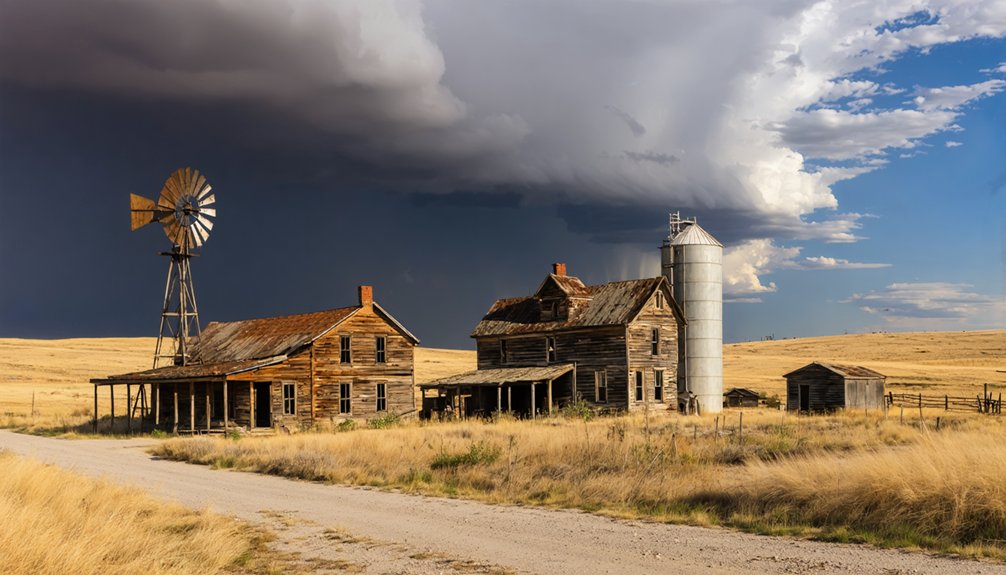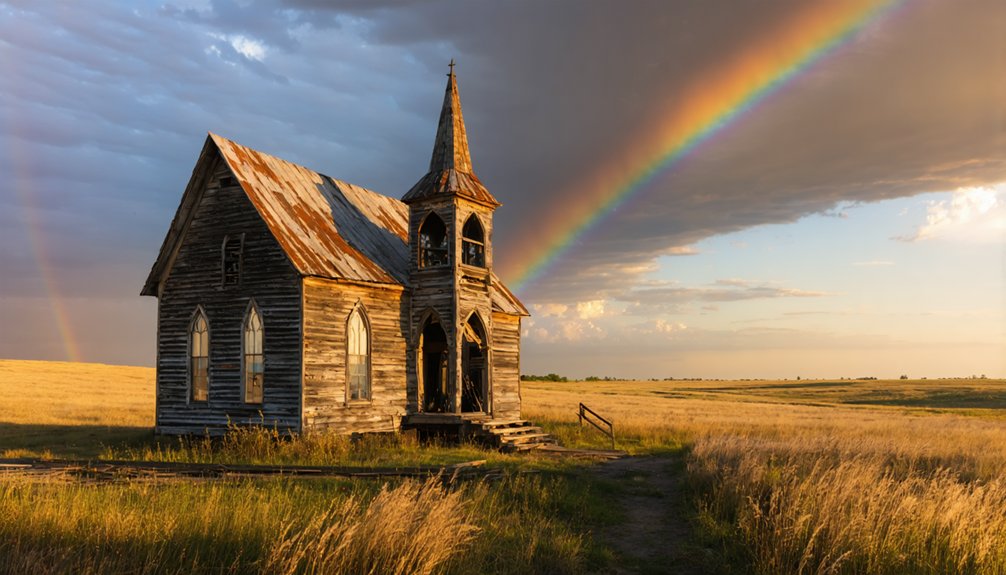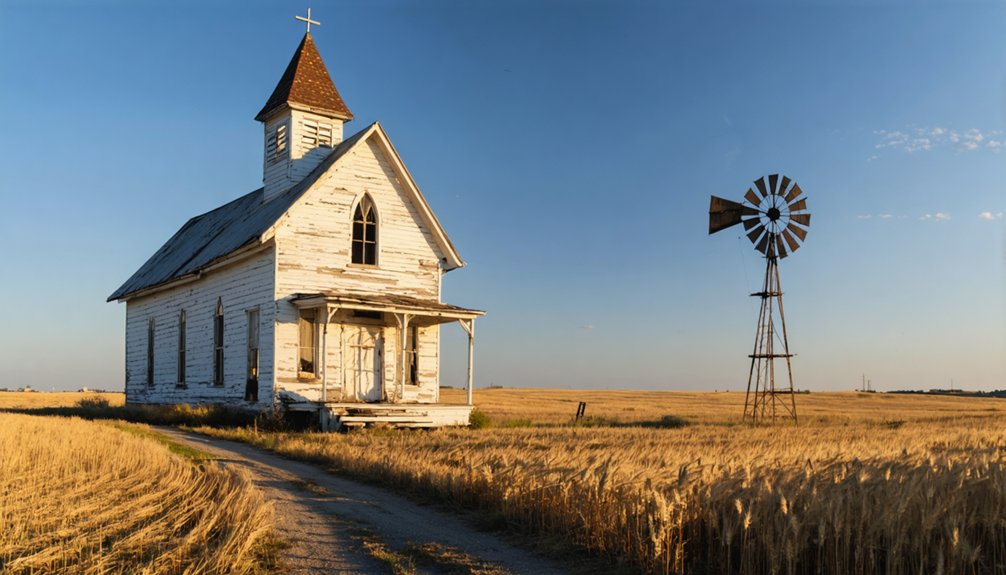You’ll find Ivanhoe nestled deep in South Dakota’s Black Hills, where gold fever sparked its birth in the 1870s. This once-bustling mining settlement featured saloons, trading posts, and a diverse community of European immigrants. Today, only scattered foundations and weathered grave markers hint at its vibrant past. The ghost town‘s abandoned mines and equipment tell tales of economic hardship, disease outbreaks, and mysterious departures that led to its ultimate downfall.
Key Takeaways
- Ivanhoe emerged as a Black Hills mining settlement in the 1870s during the gold rush, establishing essential services like trading posts.
- The town featured a diverse community of European immigrant miners, particularly from Cornwall and Germany.
- Economic challenges, costly mining operations, and the 1952 sawmill closure contributed to Ivanhoe’s eventual abandonment.
- Local legends include ghost stories about a mother and two children from 1919, adding to the town’s mysterious atmosphere.
- Today, only scattered foundations, ash heaps, and abandoned mining equipment remain as evidence of Ivanhoe’s once-thriving community.
The Lost Settlement of Ivanhoe
When gold fever struck the Black Hills in the early 1870s, the settlement of Ivanhoe emerged as a hopeful mining community amid the region’s rugged terrain.
You’ll find this fascinating piece of Ivanhoe history nestled in a strategic location that once served local mining claims and essential transportation routes. The town quickly established important services, including a post office and trading post, while miners’ cabins dotted the landscape. Like many ghost town locations, careful exploration and old maps are needed to identify remaining foundations and structures.
Though modest in size, Ivanhoe played a significant role in the area’s early mining economy. For ghost town exploration enthusiasts, it’s worth noting that this once-bustling community represented the quintessential Black Hills mining settlement, complete with the basic infrastructure needed to support the dreams of fortune-seekers during the mining camp era, only scattered remnants remain to tell its story.
Life in the Black Hills Region
In the Black Hills of the 1870s, you’d face extreme temperature swings from scorching summers to brutal winters that could trap mining settlements like Ivanhoe under feet of snow.
The region’s rugged miners built tight-knit communities centered around saloons, boarding houses, and mutual aid societies to weather the harsh conditions together. The discovery of gold in Deadwood Gulch sparked a massive rush of prospectors to the area. The Lakota tribes had considered this land sacred before miners arrived.
The region’s remote camps could only be reached by stagecoach or wagon train along treacherous mountain trails, which connected to the major supply hubs of Deadwood and Lead for essential provisions and ore transport.
Harsh Weather and Survival
Life in the Black Hills region near Ivanhoe demanded extraordinary resilience against some of America’s most extreme weather patterns.
You’d face brutal temperature swings, where Arctic air could plunge readings below zero, only to have Chinook winds suddenly warm things to the 60s°F. Your weather resilience would be tested by golf ball-sized hail, 50+ mph winds, and severe thunderstorms that could dump 10.5 inches of rain in just hours. Today’s very high fire danger in western grasslands would have been a constant threat to early settlers.
Survival strategies had to account for heavy snowfall reaching 15 inches monthly in higher elevations, while the Badlands area near Ivanhoe offered no natural windbreaks against harsh winter conditions. The region’s semiarid climate conditions meant annual rainfall rarely exceeded 17 inches, making water management crucial for settlers.
In these harsh plains, you’d contend with limited daylight hours and the constant threat of flash floods, especially in narrow drainages.
Mining Community Culture
Throughout the Black Hills gold rush, mining communities like Ivanhoe transformed from male-dominated camps into vibrant frontier settlements, where you’d find a stark social hierarchy emerging between mine owners, skilled workers, and laborers.
You’d encounter a diverse mix of European immigrants, particularly Cornish and German miners, who brought their cultural traditions to the region. The saloons and dance halls became the heart of community gatherings, offering relief from the brutal demands of underground mining.
As Ivanhoe stabilized, churches and schools appeared, though life remained challenging with expensive supplies and basic housing. In these close-knit settlements, you’d witness how the community pulled together despite harsh conditions, creating a unique frontier culture where miners and their families forged bonds through shared hardships and celebrations. The Fort Laramie Treaty violation in 1877 had led to this rapid development of mining settlements, forever changing the social landscape of the Black Hills. The discovery of gold during Custer’s expedition sparked the dramatic transformation of these lands from sacred Indigenous territory to bustling mining towns.
Transportation and Trade Routes
During the Black Hills gold rush era, you’d find a complex network of transportation routes connecting Ivanhoe and other mining settlements to essential supply lines.
You could’ve traveled along the Fort Pierre-to-Deadwood trail, originally blazed by Native Americans, or taken the Sidney-Deadwood Trail after 1876 when the North Platte River bridge opened up new trade routes.
You’d have noticed armed “shotgun messengers” protecting stagecoaches from road agents as they hauled supplies and equipment to mining camps.
By 1881, the Homestake company’s narrow-gauge railroad revolutionized transportation in the region. The Chicago, Burlington, and Quincy railroad further expanded access through its High Line construction, connecting more mining operations across the Black Hills.
As the Black Hills’ trade networks expanded, you’d see freight wagons carrying thousands of tons of goods across 200-mile trails, while rail depots became bustling centers of commerce and communication.
Mysteries of Abandonment
When you explore the crumbling remains of Ivanhoe, South Dakota today, several perplexing questions emerge about its rapid abandonment. The ghost town phenomena here follows classic abandonment theories, where multiple factors converged to seal the town’s fate.
You’ll find evidence of a once-thriving community that faced devastating economic and environmental challenges.
- Mining operations became too costly and difficult to sustain
- The 1952 sawmill closure eliminated significant jobs and economic stability
- The railroad’s departure in the 1980s isolated the community from essential trade routes
- Harsh winters and flooding repeatedly damaged buildings and infrastructure
- Disease outbreaks, including influenza epidemics, struck devastating blows to families
Unlike some Black Hills communities that managed to reinvent themselves, Ivanhoe’s population dwindled to zero as critical services and businesses shut down one by one. Much like Ardmore’s situation, the town’s demise was hastened by a severe lack of water that made daily life increasingly unsustainable.
Geographic Landscapes and Natural Features

You’ll discover Ivanhoe nestled within the Black Hills‘ distinctive landscape of rocky outcrops and forested slopes along Coolidge Creek.
The surrounding pine forests and mixed conifers create natural corridors through the rolling terrain, while native grasses flourish in the open valley areas.
The town’s location at the convergence of these diverse ecological zones made it an ideal habitat for local wildlife, from deer traversing the forested hillsides to fish populations in the creek’s waters.
Black Hills Terrain Features
The Black Hills rise dramatically from the Great Plains of South Dakota, forming a distinctive dome-shaped uplift that towers 3,000 to 4,000 feet above the surrounding plains.
You’ll find yourself surrounded by rugged ridges and varied terrain features that make this region unique. The landscape’s dome structure creates a natural fortress, complete with a resistant sandstone rim known as the hogback ridge.
- Deep valleys cut through the central Black Hills, creating broad meadow basins called “parks”
- Steep canyon walls and gorges form where rivers slice through the hogback rim
- Limestone plateaus feature solution valleys carved by weathering
- Numerous peaks and pinnacle formations dot the landscape
- Black Elk Peak stands as the highest point at 7,242 feet
Local Flora and Fauna
Standing at the edge of Ivanhoe’s ghost town boundaries, you’ll witness a rich tapestry of mixed-grass prairie dominated by bluestem, little bluestem, and western wheatgrass stretching across the rolling plains.
Native grasses share space with vibrant wildflowers like purple coneflower and prairie blazing star, creating a haven for diverse prairie wildlife.
You’ll spot white-tailed deer and pronghorn antelope roaming freely, while prairie dog colonies attract hunting coyotes and red-tailed hawks overhead.
Western meadowlarks and grasshopper sparrows dart through the vegetation, and you might glimpse the rare black-footed ferret near protected areas.
Along seasonal streams and ponds, painted turtles bask while northern leopard frogs call from the shallows, and prairie rattlesnakes keep watch from rocky outcrops.
Legacy and Local Legends
While exploring Ivanhoe’s quiet streets today, you’ll encounter a rich tapestry of local legends and mining heritage that speaks to South Dakota’s dramatic past.
Step into Ivanhoe’s haunting streets, where abandoned mines and timeworn legends whisper tales of South Dakota’s frontier spirit.
You’ll hear ghostly encounters of a mother and two children who succumbed to influenza in 1919, their spirits still said to linger near their former residence. The folklore origins blend with tales of Wild West outlaws and the town’s dramatic flood history, creating an atmosphere of mystery around the abandoned buildings and mining ruins.
- Former railroad grades now serve as hiking trails through the ghostly landscape
- Mining equipment and stamp mill remains showcase the town’s industrial past
- Historic floods contributed to Ivanhoe’s eventual abandonment
- Local historical societies preserve the town’s stories through documentation
- Former mining operations, including sawmills, operated until the mid-20th century
Exploring Historical Remnants

Nestled within South Dakota’s windswept plains, Ivanhoe’s historical remnants tell a story through scattered foundations, ash heaps, and weathered structures from its mining era.
As you explore the site, you’ll discover archaeological findings that paint a picture of the town’s brief but vibrant past, when just half a dozen houses dotted the landscape.
You can trace the old railroad grade that once connected this remote outpost to civilization, while cultural artifacts like abandoned mining equipment and building materials reveal the daily lives of former residents.
The nearby cemetery, with its weathered markers and commemorative plaques, provides a poignant connection to those who called this place home.
These physical clues help you piece together Ivanhoe’s transformation from a bustling settlement to a silent reflection of frontier ambition.
Frequently Asked Questions
Are There Any Surviving Photographs of Ivanhoe During Its Peak Years?
You’ll find it’s rather challenging to locate historical photographs from the peak years, as no surviving images have been definitively confirmed in archives, collections, or historical society records.
What Indigenous Tribes Originally Inhabited the Land Where Ivanhoe Was Established?
You’ll find that Sioux tribes, particularly the Lakota, Dakota, and Nakota bands, originally inhabited this Dakota territory, with the Lakota having the strongest presence in the western region where Ivanhoe stood.
Did Any Famous Historical Figures Ever Visit or Stay in Ivanhoe?
You won’t find records of famous visitors or historical connections to Ivanhoe in documented history. While nearby ghost towns attracted some notable figures, there’s no evidence of celebrity visits to this location.
Were There Any Major Crimes or Notable Lawmen in Ivanhoe?
You won’t find any documented major crimes or notable law enforcement figures there. The town’s crime history remains unrecorded, with no verified evidence of dedicated lawmen or significant criminal activity.
What Was the Closest Neighboring Town to Ivanhoe During Its Existence?
Ever wonder about those distant prairie settlements? You can’t definitively determine Ivanhoe’s closest neighboring towns due to limited historical records, though regional patterns suggest settlements were typically spaced 10-20 miles apart along rail lines.
References
- https://www.sdhspress.com/journal/south-dakota-history-2-2/some-black-hills-ghost-towns-and-their-origins/vol-02-no-2-some-black-hills-ghost-towns-and-their-origins.pdf
- https://www.powderhouselodge.com/black-hills-attractions/fun-attractions/ghost-towns-of-western-south-dakota/
- https://www.sdpb.org/rural-life-and-history/2023-08-21/some-black-hills-ghost-towns-and-their-origins
- https://www.youtube.com/watch?v=_0WNYsFLSLA
- https://icatchshadows.com/okaton-and-cottonwood-a-photographic-visit-to-two-south-dakota-ghost-towns/
- https://blackhillsvisitor.com/learn/maitland/
- https://en.wikipedia.org/wiki/List_of_ghost_towns_in_South_Dakota
- https://history.sd.gov/archives/verticalfile.aspx
- https://www.blackhillshikingbikingandmore.com/town-of-buffalo-gap
- https://www.deadwood.com/history/history-timeline/



